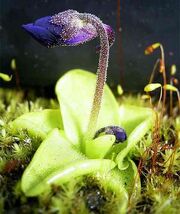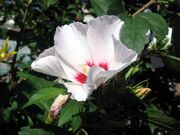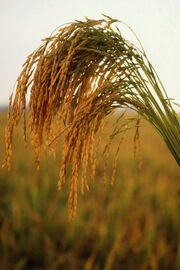
Pinguicula grandiflora commonly known as a Butterwort
Botany, plant science(s), or plant biology (from Ancient Greek βοτάνη botane, "pasture, grass, or fodder" and that from βόσκειν boskein, "to feed or to graze"), a discipline of biology, is the science of plant life. Traditionally, botany included the study of fungi, algae and viruses. Botany covers a wide range of scientific disciplines including structure, growth, reproduction, metabolism, morphogenesis, phytopathology, chemical properties, and evolutionary relationships among taxonomic groups. Botany began with early human efforts to identify edible, medicinal and poisonous plants, making it one of the oldest branches of science. Today botanists study about 400,000 species of living organisms.
Plants are essential as food and for all people and also as recreation for people who enjoy gardening, horticulture, and culinary arts.
History[]

The traditional tools of a botanist
Early botany[]
The history of botany begins with ancient writings on, and classifications of, plants. Such writings are found in several early cultures. Examples of early botanical works have been found in Ancient Indian sacred texts, ancient Zoroastrian writings, and ancient Chinese works.
Theophrastus (c. 371–287 BC) has been frequently referred to as the ”father of botany”. The Greco-Roman world produced a number of botanical works including Theophrastus's Historia Plantarum and Dioscorides' De Materia Medica from the first century.
Works from the medieval Muslim world included Ibn Wahshiyya's Nabatean Agriculture, Abū Ḥanīfa Dīnawarī's (828-896) the Book of Plants, and Ibn Bassal's The Classification of Soils. In the early 13th century, Abu al-Abbas al-Nabati, and Ibn al-Baitar (d. 1248) also wrote on botany.
Early modern botany[]

Heinrich Johann Nepomuk von Crantz's Classis cruciformium..., 1769
German physician Leonhart Fuchs (1501–1566) was one of "the three founding fathers of botany", along with Otto Brunfels (1489–1534) and Hieronymus Bock (1498–1554) (also called Hieronymus Tragus).
Valerius Cordus (1515–1544) authored a pharmacopoeia of lasting importance, the Dispensatorium in 1546. Conrad von Gesner (1516–1565) and Nicholas Culpeper (1616–1654) also published herbals covering the medicinal uses of plants. Ulisse Aldrovandi (1522–1605) was considered the "father of natural history", which included the study of plants. In 1665, using an early microscope, Robert Hooke discovered cells, a term he coined, in cork, and a short time later in living plant tissue.
During the 18th century, systems of classification became deliberately artificial and served only for the purpose of identification. These classifications are comparable to diagnostic keys, where taxa are artificially grouped in pairs by few, easily recognisable characters. The sequence of the taxa in keys is often totally unrelated to their natural or phyletic groupings. In the 18th century an increasing number of new plants had arrived in Europe, from newly discovered countries and the European colonies worldwide, and a larger amount of plants became available for study.
In 1754 Carolus Linnaeus (Carl Linnaeus) divided the plant Kingdom into 25 classes. One, the Cryptogamia, included all plants with concealed reproductive parts (mosses, liverworts and ferns), and algae and fungi.
The increased knowledge of plant anatomy, plant morphology and life cycles, lead to the realization that there were more natural affinities between plants, than the sexual system of Linnaeus indicated. Adanson (1763), Antoine Laurent de Jussieu (1789), and Candolle (1819) all proposed various alternative natural systems that were widely followed. The ideas of natural selection as a mechanism for evolution required adaptations to the Candollean system, which started the studies on evolutionary relationships and phylogenetic classifications of plants.
Botany was greatly stimulated by the appearance of the first “modern” text book, Matthias Schleiden's, published in English in 1849 as Principles of Scientific Botany.Template:Sfn Carl Willdenow examined the connection between seed dispersal and distribution, the nature of plant associations, and the impact of geological history. The cell nucleus was discovered by Robert Brown in 1831.
Modern botany[]
A considerable amount of new knowledge today is being generated from studying model plants like Arabidopsis thaliana. This weedy species in the mustard family was one of the first plants to have its genome sequenced. The sequencing of the rice (Oryza sativa) genome, its relatively small genome, and a large international research community have made rice an important cereal/grass/monocot model. Another grass species, Brachypodium distachyon is also an experimental model for understanding genetic, cellular and molecular biology.Template:Sfn Other commercially important staple foods like wheat, maize, barley, rye, pearl millet and soybean are also having their genomes sequenced. Some of these are challenging to sequence because they have more than two haploid (n) sets of chromosomes, a condition known as polyploidy, common in the plant kingdom. A green alga, Chlamydomonas reinhardtii, is model organism that has proven important in advancing knowledge of cell biology.
In 1998 the Angiosperm Phylogeny Group published a phylogeny of flowering plants based on an analysis of DNA sequences from most families of flowering plants. As a result of this work, major questions such as which families represent the earliest branches in the genealogy of angiosperms are now understood. Investigating how plant species are related to each other allows botanists to better understand the process of evolution in plants. Despite the study of model plants and DNA, there is continual ongoing work and discussion among taxonomists about how best to classify plants into various taxa.
Scope and importance of botany[]

Hibiscus
Molecular, genetic and biochemical level through organelles, cells, tissues, organs, individuals, plant populations, and communities of plants are all aspects of plant life that are studied. At each of these levels a botanist might be concerned with the classification (taxonomy), structure (anatomy and morphology), or function (physiology) of plant life.
Historically all living things were grouped as animals or plants, and botany covered all organisms not considered animals. Some organisms included in the field of botany are no longer considered to belong to the plant (plantae) kingdom, which obtain their energy via photosynthesis, – these include bacteria (studied in bacteriology), fungi (mycology) including lichen-forming fungi (lichenology), non-chlorophyte algae (phycology) and viruses (virology). However, attention is still given to these groups by botanists, and fungi (including lichens), and photosynthetic protists are usually covered in introductory botany courses.
The study of plants is vital because they are a fundamental part of life on Earth, which generates the oxygen, food, fibers, fuel and medicine that allow humans and other life forms to exist. Through photosynthesis, plants absorb carbon dioxide, a greenhouse gas that in large amounts can affect global climate. Just as importantly for us, plants release oxygen into the atmosphere during photosynthesis. Additionally, they prevent soil erosion and are influential in the water cycle. Plants are crucial to the future of human society as provide food, oxygen, beauty, medicine, habitat for animals, products for people, and create and preserve soil. Paleobotanists study ancient plants in the fossil record. It is believed that early in the Earth's history, the evolution of photosynthetic plants altered the global atmosphere of the earth, changing the ancient atmosphere by oxidation.
Human nutrition[]

Nearly all the food we eat comes (directly and indirectly) from plants, such as this American long grain rice
Virtually all foods directly or indirectly, via animals that rely on plants for nutrition, from plants. Plants are the fundamental base of nearly all food chains because they use the energy from the sun and nutrients from the soil and atmosphere, converting them into a form that can be consumed and utilized by animals; this is what ecologists call the first trophic level. Botanists also study how plants produce food we can eat and how to increase yields and therefore their work is important in mankind's ability to feed the world and provide food security for future generations, for example, through plant breeding. Botanists also study weeds, plants which are considered to be a nuisance in a particular location. Weeds are a considerable problem in agriculture, and botany provides some of the basic science used to understand how to minimize 'weed' impact in agriculture and native ecosystems. Ethnobotany is the study of the relationships between plants and people, and when this kind of study is turned to the investigation of plant-people relationships in past times, it is referred to as archaeobotany or paleoethnobotany.
Fundamental life processes[]
Botanical research has long had relevance to the understanding of fundamental biological processes other than just botany. Fundamental life processes such as cell division and protein synthesis can be studied using plants without the moral issues that come with conducting studies upon animals or humans. Gregor Mendel discovered the genetic laws of inheritance in this fashion by studying Pisum sativum (pea) inherited traits such as shape. What Mendel learned from studying plants has had far reaching benefits outside of botany. Similarly, 'jumping genes' were discovered by Barbara McClintock while she was studying maize.
Medicine and materials[]
Many medicinal and recreational drugs, like tetrahydrocannabinol, caffeine, and nicotine come directly from the plant kingdom. Others are simple derivatives of botanical natural products; for example, aspirin is based on the pain killer salicylic acid which originally came from the bark of willow trees. As well, the narcotic analgesics such as morphine are derived from the opium poppy. There may be many novel cures for diseases provided by plants, waiting to be discovered. Popular stimulants like coffee, chocolate, tobacco, and tea also come from plants. Most alcoholic beverages come from fermenting plants such as barley (beer), rice (sake) and grapes (wine).
Hemp, cotton, wood, paper, linen, vegetable oils, some types of rope, and rubber are examples of materials made from plants. Silk can only be made by using the mulberry plant. Sugarcane, rapeseed, soy are some of the plants with a highly fermentable sugar or oil content which have recently been put to use as sources of biofuels, which are important alternatives to fossil fuels.
Environmental changes[]
In many different ways, plants can act a little like the 'miners' canary', an early warning system alerting us to important changes in our environment. Plants respond to and provide understanding of changes in on the environment:
- Plant systematics and taxonomy are essential to understanding habitat destruction and species extinction.
- Ultraviolet radiation causes changes in plants which help in studying problems like ozone depletion.
- Analyzing pollen from by plants thousands or millions of years ago allows reconstruct of past climates and predicting future ones; which is essential to climate change research.
- Study of plant life cycles is an important part of phenology, which is used in climate-change research.
Research[]
Structural[]
Understanding the structure and function of cells is fundamental to all of the biological sciences. All organisms have cells. Cell biology studies their structural and physiological properties. This includes responses to stimuli, reproduction, and development on the macroscopic scale, microscopic scale, and molecular level. The similarities and differences between the function of a cell are quite varied. Plant cells are eukaryotic, ie, have a membrane-encased nucleus that carries genetic material.{ With rare exceptions, plant cells also have a central vacuole, cytoplasm, cytosol, Golgi apparatus, endoplasmic reticulum, microbodies, microfilaments, microtubules, mitochondria, plasma membrane, plastids, protoplasm, ribosomes, storage products, and a cell wall. Cells divide by processes known as karyokinesis and cytokinesis.
The body of a plant contains three basic parts: roots, stems, and leaves. Roots anchor it to the ground, gather water and mineral nutrients from the soil, and produce hormones. Stems provide support to the leaves and store nutrients. Leaves gather sunlight and begin photosynthesis. Large, flat, flexible, green leaves are called foliage leaves. Angiosperms are seed-producing plants that produce flowers, having closed seeds. Gymnosperms are seed-producing plants which have open seeds, such as conifers, cycads, Gingko, and gnetophyta.
Systematics[]

Linnaeus's table of the Plant Kingdom ("Regnum Vegetabile") from the first edition of Systema Naturae (1735).
Botanical Classification is a method by which botanists group and categorize organisms by biological type, such as genus or species. Botanical classification is a form of Taxonomy. Modern taxonomy is rooted in the work of Carolus Linnaeus, who grouped species according to shared physical characteristics. These groupings have since been revised to improve consistency with the Darwinian principle of common descent. While scientists do not always agree on how to classify organisms, molecular phylogenetics, which uses DNA sequences as data, has driven many recent revisions along more efficient, evolutionary lines and is likely to continue to do so. Botanical classification belongs to the science of plant systematics. The dominant classification system is called the Linnaean taxonomy. It includes ranks and binomial nomenclature. The classification, taxonomy, and nomenclature of botanical organisms is administered by the International Code of Nomenclature for algae, fungi, and plants (ICN).
The five-kingdom system has largely been superseded by modern alternative classification systems generally begin with the three-domain system: Archaea (originally Archaebacteria); Bacteria (originally Eubacteria); Eukaryota (including protists, fungi, plants, and animals). These domains reflect whether the cells have nuclei or not, as well as differences in the chemical composition of the cell exteriors.
Further, each kingdom is broken down recursively until each species is separately classified. The order is: Domain; Kingdom; [[Division]; Class; Order; Family; Genus; Species. The scientific name of an organism is generated from its genus and species, resulting in a single world-wide name for each organism. For example, the Tiger Lily is listed as Lilium columbianum. Lilium is the genus, and columbianum the species. When writing the scientific name of an organism, it is proper to capitalize the first letter in the genus and put all of the species in lowercase. Additionally, the entire term may be italicized or underlined. Phylogenetics is the study of similarities among different specie
Subdisciplines of botany[]
|
|
†Fungi are a distinct species apart from plants. However, for practical purposes mycology is included as a subdiscipline of botany.
See also[]
- Botanical garden and List of botanical gardens
- Dendrochronology
- Edible Flowers
- Flowers and List of flowers
- Herbs
- Seeds
- Soil science
- Trees
- Vegetation
- Weed science
External links[]
- Botany databases at the Hunt Institute for Botanical Documentation
- Directory of Plants (PDF)
- High quality pictures of plants and information about them from Catholic University of Leuven
- Native Plant Information Network
- USDA plant database
- The Virtual Library of Botany